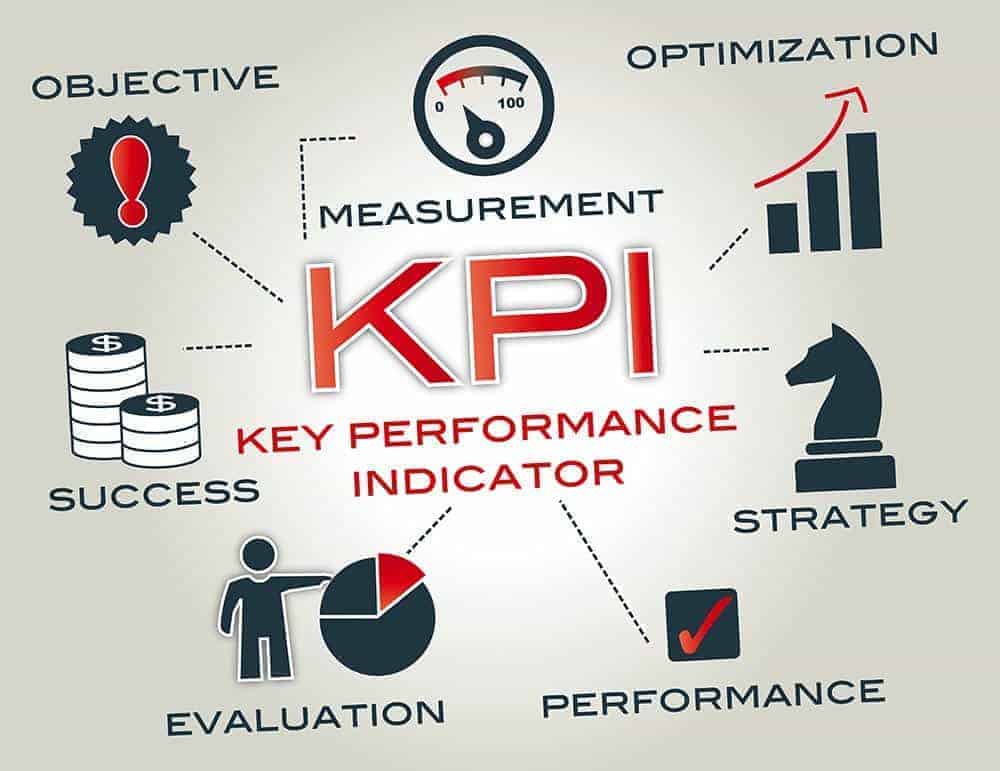Key Performance Indicators or KPI’s are pre-determined benchmarks used to measure or track the effectiveness of processes currently implemented to achieve your business objective.
KPI’s are also alternatively referred to as metrics.
The KPI’s of one business will be different from another. Determining the KPI’s would depend on the industry, type of organization and what the business hopes to accomplish.
A small business owner retailing fashion apparel would have a different set of KPI’s compared to a company that is publicly listed in the stock exchange.
For the retailer, his objective would be to increase sales revenue. There are several ways the business owner can approach this objective. These approaches involve implementing specific processes and functions that were designed to improve the level of sales.
But not all of these processes will generate the same results. Some may not even work at all. Some may even run contrary to your objective and produce worse results.
On the other hand, the publicly listed company’s objective would be to increase its stock price. Applying the KPI’s of the small fashion retailer would not help the publicly listed company accomplish its objective because improving the stock price involves considerations other than just increasing sales.
The set of KPI’s established by a business will also vary in terms of importance. A company that provides customer service will prioritize KPI’s that measure turnaround time (TAT) and ratio of resolved versus unresolved issues.
Meanwhile an owner of a fast-food business will most likely place more focus on metrics that track food cost, profitability and customer turnover.
The Importance of Having KPI’s for Your Business
KPI’s provide you the basis to analyze if these processes or functions are helping you stay on course toward achieving your goal. In the absence of a system of measuring performance, an organization’s management team would have no meaningful way of evaluating the effectiveness of its current strategies.
A company may end up allocating more resources to fund a process that is constantly under-delivering results. Management would have no reference point to determine what changes need to be made to improve its operational system.
Metrics and performance benchmarks are also necessary to keep employees focused on the company’s goals as well as their personal improvement.
For example, a company that provides moderation services use KPI’s that measure the employee’s ability to identify potential violations and their accuracy in citing the specific guideline.
A third metric to consider would be work ethic which is composed of timekeeping records, performance evaluation results, tests and number of infraction notices received.
The result of the KPI evaluation would give the company empirical basis for retaining, promoting or terminating the employee without risk of being accused of unfair labor practices.
Business owners and top level executives can use KPI’s to identify potential outcomes that could pose problems in the future. Foreshadowing threats will give organizations more time to develop the appropriate courses of action.
Types of KPI’s
While the kinds of metrics a business may use could be different from the ones used by another organization, generally, there are only 2 types of KPI’s:
- Lagging Indicators – Measures results of business activities that have already occurred. Examples of Lagging Indicators are quarterly profit and revenue growth and other versions of financial statements.
- Leading Indicators – These are metrics that provide guidance on future results. Examples of Leading Indicators are sales bookings and customer surveys.
Businesses that are looking to develop a set of KPI’s must strive to find a balance between lagging and leading indicators.
Another factor to consider is the difference between quantitative and qualitative indicators.
Quantitative indicators have a numerical basis; its result is confirmed or validated by a number or figure that corresponds to actual performance. Qualitative is much more abstract and subject to interpretation.
A good example of a qualitative indicator would be statistics on the number of terminated transactions on an E-commerce website’s checkout counter. If the number of terminated transactions is high, it could be an indicator of poor User Experience (UX).
How to Develop KPI’s for Your Business
There is no strict rule on how to develop KPI’s for your business. However, we have a system which you can use as a reference to help you come up with your own set of metrics:
- Identify – Conduct a thorough review of your business model and pinpoint your objective. Identify a set of KPI’s that you believe would best measure the performance of your company or a specific department.
- Create – Once you have identified the KPI’s, develop a system of measuring performance and displaying results.
- Evaluate – Even CEO’s need help evaluating KPI’s. If you have a team, distribute a copy of the KPI results to everyone and ask each one to contribute their analysis.
- Change – If the team has arrived at a consensus on the end result of the KPI’s, identify which processes and functions are producing the lowest ROI. The options are to revise parameters of the processes, reduce its level of involvement or outright discontinuation.
- Reassess – Come up with an objective reassessment of the KPI’s and your proximity to the stated goal or objective.
Let’s put this all together by using our earlier example on the moderation services company. For purposes of the discussion, let’s call the moderation services company, Benchmark Global.
- Identify – Benchmark Global has a client from Australia that is involved in the entertainment industry. The client has social media platforms that allow chat and posting of images.
The client has instructed Benchmark to reduce the number of complaints from users. The complaints range from offensive content and inconsistent tagging of inappropriate posts.
- Create – Benchmark has identified “Statistics”, “Accuracy” and “Work Ethic” as the KPI’s.
Statistics refers to the volume of inappropriate posts and offensive content tagged by the moderator. Accuracy refers to the moderator’s precision in tagging the post according to the appropriate guideline. Work Ethic refers to moderator’s overall attitude while on duty.
The questions to be answered were the following:
- Statistics – “How many messages or content did the moderator tag?”
- Accuracy – “Were these messages tagged according to moderation guidelines?”
- Work Ethic – “Were there extraneous factors that contributed to the drop in moderation quality?”
The Head Moderator has reviewed all the trouble tickets that covered these complaints and has asked the Quality Assurance Officer to confirm the validity of the claims by cross-referencing the tagged post to the appropriate moderation guideline.
The Performance Analyst will review the historical performance of the moderators involved with the posts in question and will try to find inconsistencies, trends, patterns and potential pain points.
- Evaluate – Benchmark’s moderation management team is composed of the Head Moderator, Performance Analyst and Quality Assurance Officer. They have applied the following weights on each metric:
- Accuracy – 60%
- Statistics – 30%
- Work Ethic – 10%
The company has decided to focus on improving on quality of work instead of increasing the volume of tagged posts. Benchmark theorizes that as quality improves, the volume of tagged posts will increase accordingly.
- Change – Benchmark has seen that accuracy may have been compromised because a good number of moderators were consistently late for work and the rate of absenteeism has increased significantly. The company has decided to revise the weights as follows:
- Accuracy – 50%
- Statistics – 30%
- Work Ethic – 20%
Supervisors were instructed to tighten up on time-keeping and to penalize habitually tardy moderators. Company policy had outlined specific courses of action to take during incidents of tardiness and absenteeism.
These courses of action included distribution of memos and an adjudication process if warranted.
- Reassess – Benchmark’s moderation performance slightly dipped last quarter as evidenced by the decrease in accuracy but an increase in statistics. the company is confident it can recover lost ground with the newest adjustments in KPI’s.
It identified deteriorating levels of discipline as one of the possible causes. If moderators are routinely absent or late at work, the quality and consistency of moderation will suffer.
The inverse relationship between accuracy and statistics led to one conclusion: Moderators had gotten sloppy at work.
By implementing disciplinary rules as the supervisors should have done in the first place, moderators may start taking their duties more seriously.
In order to stay on course, Benchmark may consider re-training the moderators and/or terminating those who exhibited unprofessional behavior at work.
KPI’s should always remain dynamic or flexible because business conditions can change without warning. The processes and functions which did not contribute to the success of your campaign this year may become valuable next year.
The normal course of action is to use business analytics to develop your set of KPI’s. Analytics can be data collected from your website, social media pages and online marketing programs.
You can read more about analytics in our article “Why is Analytics Important in Marketing?”
Conclusion
The important thing to remember when running a business is to always stay on top of your performance by keeping track of your numbers. A website is a must if you want to be competitive in the industry. It is the hub of all of your online activities.
Ask your web designer or developer to pull out your site’s analytics on a monthly basis and discuss the numbers with you. In time and with consistency you will become more proficient in analyzing your numbers.
The same goes for marketing analytics. Consult with your Digital Marketer and determine which online platforms and networks are generating the highest ROI.
A very important rule to remember is to keep your metrics simple. You can get lost in the number of processes you can use to measure business performance.
When it comes to KPI’s, more isn’t better. If there are too many indicators to review and evaluate, you can get confused and find yourself veering off- course from your original intent.
We hope you enjoyed our article on KPI’s and found it highly informative. If you would like to know more about metrics and performance benchmarks and how it applies to business, please feel free to give us a call or an email.







